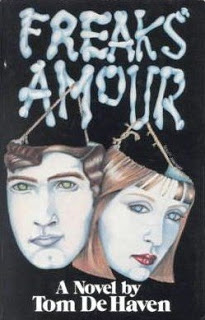 By TOM DE HAVEN (Morrow; 1979)
By TOM DE HAVEN (Morrow; 1979)
A classic of freak lit that predated the better-known GEEK LOVE by nearly a full decade. FREAKS’ AMOUR would appear to have been an influence on the latter novel in its notably perceptive depiction of the day-to-day lives of some severely deformed individuals. The novel also had a definite (if unintended) real-life corollary, as its initial 1979 publication occurred a week before the accident at Three-Mile Island, which paralleled the nuclear explosion that sets FREAKS’ AMOUR in motion.
That calamity is known as Caliban’s Night, which takes place in New Jersey in the “future” year 1988, and causes widespread mutations among its survivors. Among those survivors are the parents of Grinner, the narrator, and his twin brother Flourface. Grinner, so named because his face is twisted into a permanent grin, grows up to be a more-or-less upstanding citizen. As for Flourface, cursed with a flour-white face and pin-prick eyes, he becomes a dealer in mutant goldfish eggs, which are highly illegal, as when they’re imbibed they cause one to literally die for short periods.
Grinner marries Reeni, a furry troll-like fellow freak with whom he performs a pornographic stage show involving rape and brutality. Their object is to raise money for “syntha-skin” transplants that promise to make them appear normal. But Reeni is addicted to goldfish eggs (while Grinner contents himself with popping salt pills), and Grinner’s life is further rattled by the intervention of Sharkey, an agent of BORD (the Bureau of Restricted Drugs) who’s naturally quite interested in Flourface’s activities.
FREAKS’ AMOUR is quite insightful in its depiction of the lives of Grinner and his companions, and distinguished by the author’s considerable imaginative heft and descriptive power. It’s with the intervention of Sharkey, at roughly the halfway point, that the story changes from a picturesque, character-based account to a quasi-science fiction thriller, with Grinner uncovering a widespread conspiracy involving the fish eggs, whose effects aren’t as random as they might seem. This latter half, unfortunately, is far less compelling than the early sections, which are like nothing else in their fecund strangeness, and probably explains why this novel never attained the success of the aforementioned GEEK LOVE.
